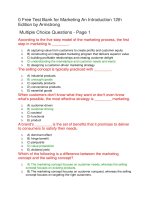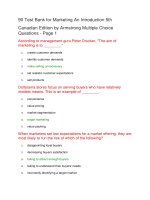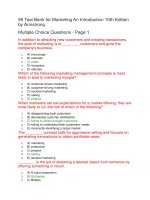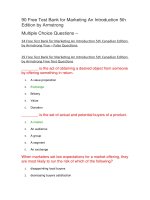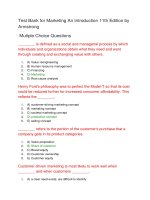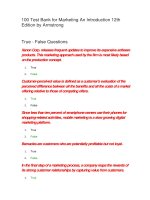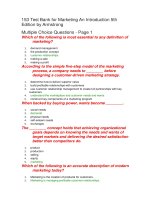Hospitality marketing an introduction
Bạn đang xem bản rút gọn của tài liệu. Xem và tải ngay bản đầy đủ của tài liệu tại đây (2.61 MB, 363 trang )
Hospitality Marketing
Hospitality Marketing
An introduction
David Bowie and Francis Buttle
AMSTERDAM BOSTON HEIDELBERG LONDON NEW YORK OXFORD
PARIS SAN DIEGO SAN FRANCISCO SINGAPORE SYDNEY TOKYO
Elsevier Butterworth-Heinemann
Linacre House, Jordan Hill, Oxford OX2 8DP
200 Wheeler Road, Burlington, MA 01803
First published 2004
Copyright © 2004, David Bowie and Francis Buttle. All rights reserved
The right of David Bowie and Francis Buttle to be identified as the authors
of this work has been asserted in accordance with the Copyright, Designs
and Patents Act 1988
No part of this publication may be reproduced in any material form (including
photocopying or storing in any medium by electronic means and whether
or not transiently or incidentally to some other use of this publication) without
the written permission of the copyright holder except in accordance with the
provisions of the Copyright, Designs and Patents Act 1988 or under the terms of
a licence issued by the Copyright Licensing Agency Ltd, 90 Tottenham Court Road,
London, England W1T 4LP. Applications for the copyright holder’s written
permission to reproduce any part of this publication should be addressed
to the publisher
Permissions may be sought directly from Elsevier’s Science & Technology Rights
Department in Oxford, UK: phone: (ϩ44) 1865 843830, fax: (ϩ44) 1865 853333,
email: You may also complete your request on-line via
the Elsevier homepage (www.elsevier.com), by selecting ‘Customer Support’
and then ‘Obtaining Permissions’
British Library Cataloguing in Publication Data
A catalogue record for this book is available from the British Library
Library of Congress Cataloguing in Publication Data
A catalogue record for this book is available from the Library of Congress
ISBN 0 7506 5245 4
For information on all Elsevier Butterworth-Heinemann
publications visit our website at
Typeset by Newgen Imaging Systems (P) Ltd., Chennai, India
Printed and bound in Italy
For Julie, Olive, James
and Rowan, Cherry and James
DB
For my parents Bill and Mary, and Dale and Nick
FB
Contents
Preface
Structure and learning features
Acknowledgements
ix
x
xi
Part A: Introduction
1 Introduction to hospitality marketing
3
Part B: Pre-encounter marketing
2 Marketing research
3 Understanding and segmenting customers
4 Competitive strategies
5 Developing the offer
6 Locating the offer
7 Pricing the offer
8 Distributing the offer
9 Communicating the offer
37
53
85
115
133
149
175
195
Part C: Encounter marketing
10 Managing the physical environment
11 Managing service processes
12 Managing customer-contact employees
229
245
263
Part D: Post-encounter marketing
13 Managing customer satisfaction
14 Relationship marketing
281
297
Part E: The marketing plan
15
Marketing planning
Index
315
341
Preface
Most readers of this textbook will be university undergraduate or college students studying hospitality and/or tourism marketing for the first time. Our main objective in writing the book has
been to provide you with an easy-to-read text, which presents a review of modern marketing theory in the context of marketing the hospitality industry. Examples from the industry are provided
to illustrate real-life practice and give you a better understanding of hospitality marketing.
The book has the following special features:
᭹
᭹
᭹
᭹
A unique structure, which divides marketing activities into before, during and after the customers’ experience of the hospitality encounter. This helps you to understand what has to be
done to attract customers, provide them with an experience that meets their expectations, and
motivate them to return.
Fifteen chapters, one for each of the key elements you need to understand about marketing.
Each chapter contains learning activities, which include Internet searches of relevant company
websites and visits to hospitality units as a customer to collect information – you will then need
to analyze and evaluate your findings.
Its own website ( which contains a student section with further information, case studies and hospitality contact details. For tutors,
there is a separate section, which provides additional teaching materials.
Structure
The structure of the book is divided into the following sections:
●
●
●
●
●
Part A: Introduction. A single chapter, which introduces the key concepts of marketing in the hospitality industry, including market demand, the marketing concept, the special characteristics
of service industries, the PESTE environment and the hospitality marketing mix.
Part B: Pre-encounter marketing. This part of the text consists of eight chapters and discusses all
the marketing activities which companies have to carry out to attract customers to experience
the hospitality offer. Chapters include marketing research; understanding and segmenting customers; competitive strategies; developing, locating, pricing, distributing and communicating
the offer.
Part C: Encounter marketing. This section comprises three chapters, which are concerned with
managing the customer experience, while consuming the hospitality offer. They include managing the physical environment, managing the service process and managing customer contact
employees.
Part D: Post-encounter marketing. These two chapters discuss post-encounter marketing and
explain the importance of customer satisfaction and developing mutually beneficial relationships with key customers.
Part E: The marketing plan. The final chapter builds on the previous chapters, and explains how
to write a marketing plan for a hospitality business.
Learning features
Each chapter contains the following features to aid understanding:
●
●
●
●
●
●
●
Chapter Objectives: Each chapter begins with bullet points highlighting the main features and
learning to be covered in the proceeding chapter.
Activities: Short practical activities located at appropriate ‘break’ points throughout the chapter,
which enable the reader to assess their understanding and marketing experience.
Headlines: Highlights, appearing in blue type, throughout the chapter, which bring important
points to the attention of the reader.
Marketing Insights: Marketing anecdotes and observations to contextualize learning.
Case Studies: International companies and scenarios are used to illustrate how the theories work
in real world situations.
Conclusion: Condenses the main themes of the chapter enabling the reader to check learning and
understanding.
Review Questions: Appear at the end of each chapter allowing readers to test their knowledge,
understanding and to put the theory into practice.
Acknowledgements
We would like to thank the following people who have provided advice, materials and support
throughout the writing of this book:
Colleagues from the Department of Hospitality, Leisure and Tourism Management at Oxford
Brookes University: Ian Baldwin, Nina Becket, Dr David Bowen, Maureen Brookes, Dr Jackie
Clark, Grant Clendining, Dr Liz Doherty, Phil Harpley, Professor Peter Harris, Professor Victor
Middleton, Kathy and Ian Mitchell, Alex Paraskevas, Mike Rimmington, Clive Robertson,
Dr Angela Roper, and Donald Sloan.
Hospitality industry practitioners: Rowan Aragues, Pauline and David Baldwin, James Bowie,
Pamela Carvell, Francesca Castelli, Julia Clarke, John Clifford, Richard Coates, Thierry Douin,
Cherry Fleet, Louise Flemming, Chris Grant, John Griffin, Stuart Harrison, David Hayes, Erik
Marsh, Alasdair McNee, Nicky Michellietti, Sophie Mogford, Philip Pickering, Rupert Power,
Nick Read, Paul Simmons, Cris Tarrant, Gerard Tempest, and Gary Yates.
Part A
Introduction
Chapter 1
Introduction to
hospitality marketing
Chapter Objectives
After working through this chapter, you should be able to:
Define key marketing terms and understand the ‘marketing concept’
Describe major environmental influences which impact on hospitality customers and
organizations
Explain the special characteristics of service businesses to which marketers need to respond
Identify the eight elements of the hospitality marketing mix.
4 Hospitality Marketing
Introduction
In this chapter, you will be introduced to the key concepts of marketing. We will start
by explaining what a market is, and reviewing different definitions of marketing.
We will then discuss the macro- and micro-environments in which hospitality
companies operate, the special characteristics of services marketing, and the hospitality
marketing mix.
Whether we recognize it or not, we are all involved, willingly or unwillingly, in
marketing. We come into contact with marketing practice every day as customers
making buying decisions and at work, even if we do not have a job in marketing.
Although marketing has a powerful influence in modern life, it is often misrepresented and misunderstood.
Students learning about marketing for the first time can be confused, because
academic definitions of marketing differ from the everyday use of the term. Students
can also be confused about the role of marketing, since marketing is both a business
philosophy and a management function.
Activity 1.1
᭹
Write down what you think ‘marketing’ means, before reading the
chapter
᭹
Write down what you think marketers do
᭹
List the jobs that you think marketers are responsible for.
We will review your ideas at the end of this chapter and see whether they
have changed!
What is a market?
Originally a market was a meeting place where people could buy and sell produce,
and of course this type of market still exists today. In modern societies a ‘market’ is
much more complex, but retains the core principles of bringing together buyers and
sellers with common interests. This modern concept of the market is based on
groups of people who have similar needs and wants (actual and potential buyers or
consumers), and companies that aim to satisfy the consumers’ needs and wants better than their competitors (an industry). Needs can range from the basic requirements for survival – food, shelter, safety – to much more complex social needs, such
as belonging and recognition.
Wants are how different people choose to satisfy their needs, and are shaped by
culture and personality. Hence people with similar needs, for example the need to
travel for a family event and stay overnight, can have different wants – some may
stay with relatives while others book their own hotel accommodation. Obviously,
a major limitation on how people can satisfy their wants is the amount they can
afford to pay.
Introduction to hospitality marketing 5
Consumers have to make buying choices based on their own resources or buying
power. Consumers will often buy the best bundle of benefits provided by a product,
for the price that can be afforded. The combined purchase decisions of all the individuals buying a product (or service) is described as market demand. Market demand
is normally measured using two criteria:
1 The number of units sold, which is a reflection of the number of people buying
the product or service; this is called the volume
2 How much people have paid for the product; this is called the value.
Individuals can choose different ways to satisfy similar needs. Not everyone wants
the same bundle of benefits, and this creates sub-markets, or market segments,
within the overall market. In hospitality markets, luxury, mid-market and budget
market segments represent different bundles of benefits sought by different groups
of customers. Over a period of time the volume and the value of market segments
can increase or fall, depending upon a wide range of factors.
Market supply can also be measured, and this is called the industry capacity. In the
hotel market, the number of hotels and bedrooms in an area is called the market
capacity. If the number of hotels and bedrooms is increasing, because new hotels or
bedroom extensions have been built, then the market capacity increases. In the hospitality industry, market supply is often categorized under the same headings as
market demand segments; so the luxury, mid-market and budget classifications are
used to describe the different types of operations serving those market segments.
Other ways of categorizing hospitality market supply include:
᭹
᭹
᭹
Tourist board, motoring, or other, organization ratings for hotels and restaurants
(e.g. star rating classification)
Purpose of travel (leisure or business)
Niche markets (youth action adventure holidays, conferences or gourmet food).
The level of market demand and the amount of industry capacity is a crucial factor
underpinning the profitability of hospitality markets:
᭹
᭹
When market demand is consistently high and industry capacity low, the hospitality business should be operating at high capacity and be profitable
When market demand fluctuates and industry capacity is high, the hospitality
business will be operating in a highly competitive environment and profitability
will rise and fall.
Categories of demand
One way to think about marketing is to view it as the art and science of managing
customer demand. Because demand states vary, so does the task of marketing.
Table 1.1 provides a list of eight categories of demand and the marketing
response. Where demand states 1–4 occur, actual demand is lower than the desired
level of demand and the hospitality marketer is primarily interested in facilitating
and stimulating more consumption. Negative demand exists where consumers
positively dislike a product – e.g. an unpopular food or drink product. The marketing response is to encourage demand by educating consumers about the positive
6 Hospitality Marketing
Table 1.1 Demand Management (source: taken from Philip Kotler, Marketing
Management, 11th edn, 2003, p. 6)
1
2
3
4
5
6
7
8
Category of demand
Marketing task
Negative demand
No demand
Latent demand
Falling demand
Irregular demand
Full demand
Overfull demand
Unwholesome demand
Encourage demand
Create demand
Develop demand
Revitalize demand
Synchronize demand
Maintain demand
Reduce demand
Destroy demand
features of, or benefits from, the product. You can often witness free tastings of food
and drink products in supermarkets and wine shops, which enable potential
customers to see, taste and buy the product.
Where there is no demand, the marketing task is to create demand. Raising
awareness by advertising and public relations activity to demonstrate a product’s
positive attributes will help to educate consumers, and encourage them to sample
the product.
Latent demand means that demand would exist if there were a product/service
available to meet consumer needs. The development of domestic short breaks as a
hotel product was originally based on consumers’ increasing affluence and
available leisure time.
Where demand is falling, the task is to revitalize demand. This situation can occur
when a product/service is beginning to lose its appeal. Marketers need to research
the reasons why the product no longer meets consumers’ needs, reformulate the offer
and re-launch the product to stimulate consumer interests and revitalize demand.
Irregular demand can be described in hospitality markets as the seasonality of
demand. In these situations, companies strive to develop marketing strategies to
synchronize demand over the high and low seasons, often using price-led
promotions.
Full demand occurs when actual demand matches the desired demand, and the
marketing task is to maintain current demand. In hospitality markets full demand
rarely occurs, since competitors are likely to enter attractive markets and disturb the
equilibrium.
If there is too much (or overfull) demand, the service operation will not be able to
cope and there is likely to be considerable customer dissatisfaction. The hospitality
marketer will aim to reduce demand either by increasing prices or by managing the
booking/queuing process to prevent overfull demand. A long-term solution to
overfull demand is to increase capacity by building more bedrooms or extending
the seating area in a restaurant, but managers need to be confident that overfull
demand will be sustained.
Unwholesome demand can occur when illegal activities such as drug taking,
gambling or prostitution are taking place on the hospitality premises. Management
clearly has a legal and ethical duty to try and inhibit or destroy unwholesome
demand; however, this can be a difficult situation when customers are willingly
involved.
Introduction to hospitality marketing 7
Table 1.2 Categories of Demand in Hospitality
Business
Leisure
Domestic
International
Domestic business demand
Domestic leisure demand
International business demand
International leisure demand
Market demand in hospitality
Market demand in hospitality can be broadly described under four key headings:
1 Business travel demand includes all those journeys business people make to meet
customers and suppliers, and attend conferences, exhibitions and seminars.
Business travel does not include the daily journeys people make when commuting to work.
2 Leisure travel demand includes journeys where people travel away from home
for amusement, entertainment or relaxation – for example, holidays, weekend
breaks, or same-day visits.
3 Domestic travel demand includes all the travel generated within a country by
people living in that country – so, for example, the domestic demand for business
travel in Australia is all business journeys taken in Australia by people living in
Australia.
4 International travel demand includes all the journeys generated to a country from
people living in other countries. France is one of the most popular tourist destinations, and attracts international visitors from all over the world.
Some types of travel do not fit easily into these broad categories. People often combine business and holidays in the same trip. However, these are convenient descriptions which tourist and hospitality organizations use. Table 1.2 summarizes these
descriptors of market demand in hospitality.
What is marketing?
The philosophy of marketing
One set of marketing definitions suggests that marketing is primarily a business
philosophy that puts the customer first. From this perspective, the primary goal of
hospitality businesses should be to create and retain satisfied customers. This concept proposes that satisfying customers’ needs and wants should be at the center of
an organization’s decision-making process. Professional marketers believe that this
customer focus is the responsibility of everybody in the organization. Adopting this
philosophy requires a total management commitment to the customer, and companies that pursue this approach can be described as having a customer orientation.
Definitions of marketing
Early definitions of marketing centered on the exchange/transaction process.
Kotler (2000) proposes that in order to satisfy people’s needs and wants, products
8 Hospitality Marketing
and services are exchanged in mutually rewarding transactions generally, but not
exclusively, using the monetary system. Kotler originally suggested that this
exchange process, now known as transaction marketing, is a core concept in marketing, and is a ‘value-creating process which leaves both parties better off than
before the exchange took place’.
Another set of definitions suggests that marketing is a management process
aimed at delivering customer satisfaction. Examples of this approach include the
definitions offered by the Chartered Institute of Marketing, and the American
Marketing Association. These definitions introduce a crucial aspect of marketing
management – planning, which is discussed in greater detail later but is implicit in
all of an organization’s marketing activities.
These earlier definitions of marketing have been criticized on the grounds that the
transactional focus is on generating first-time sales only. Relationship marketing
evolved as a response to that criticism, and has become more fashionable as
academics and practitioners recognize that the lifetime value of a customer can be
high, even if the value of each transaction is relatively low. Relationship marketing
is the development of mutually beneficial long-term relationships between suppliers and customers. In hospitality markets, a ‘relationship marketing’ approach
has seen the major hotel groups focus their marketing activities upon frequent
travelers in an attempt at encouraging repeat and recommended business.
Marketing
insight
Different Perspectives of Marketing
‘Marketing is the management process responsible for identifying, anticipating
and satisfying customer requirements profitably.’
(Chartered Institute of Marketing, UK)
‘Marketing is the process of planning and executing the conception, pricing,
promotion, and distribution of ideas, goods and services to create exchanges
that satisfy individual and organizational objectives.’
(American Marketing Association)
‘In services, every contact between customers and employees includes an
element of marketing.’
(Jan Carlzon, 1987)
Relationship marketing aims to ‘identify and establish, maintain and enhance,
and where necessary, terminate relationships with customers and other stakeholders, at a profit so that the objectives of all parties involved are met; and
this is done by mutual exchange and fulfillment of promises.’
(Christian Grönroos, 1994)
‘Marketing’s central purpose is demand management … and marketers … need
to manage the level, timing and composition of demand.’
(Philip Kotler, 1999)
Introduction to hospitality marketing 9
Delighting the customer
Another view of marketing proposes that satisfying customers is no longer enough
in a competitive environment. Companies, striving to develop sustainable competitive advantage, compete by ‘delighting their customers’ to ensure repeat and recommended business. Albrecht (1992) suggests that there are four product levels that
companies can offer (see Figure 1.1):
1 At the basic level, a company provides essential core attributes (e.g. a clean bed)
that customers need. If this basic level is not provided, customers will not buy the
product – if the bed is not clean, customers will not be satisfied and might check
out of the hotel. A hospitality firm that only offers a basic level of value is not
competitive, and is unlikely to generate significant repeat and recommended
business.
2 At the expected level, a company provides attributes that customers expect and
take for granted – for example, efficient check in, a clean bed and availability of a
bar/restaurant might be examples of the attributes expected from a mid-scale
hotel. A hospitality company providing attributes at the expected level is only
providing an average standard service; there is nothing better about the service
offer compared to the competition. Customers may only be moderately satisfied,
and there is no incentive to return or recommend this company.
3 At the desirable level, a company provides attributes that customers know of but
do not generally expect. The friendliness of the staff, the quality of the food and
the efficiency of the service are examples of attributes that customers know, but
do not always expect. Companies providing the desirable offer are competing
more effectively than most of their competitors.
Unanticipated
Desirable
Expected
Basic
Figure 1.1 The hierarchy of customer value (adapted from Albrecht, 1992)
10 Hospitality Marketing
4 At the unanticipated level, hospitality operators offer customers ‘delightful
and surprising’ attributes that demonstrate outstanding service quality.
Examples might include imaginative decor and fittings, staff who perform
exceptional service, or cuisine with unforgettable taste sensations. Companies
operating at the unanticipated level can be said to delight their customers with
memorable experiences, and are achieving a significant advantage over their
competitors.
The difficulty with providing unanticipated levels of service all the time is that
customers begin to expect these delightful surprises, and competitors copy them.
Managing demand
All these different definitions must seem quite confusing, particularly when many
people who work in marketing are actually involved with increasing sales via
promotional activity. Most hospitality marketers are employees in sales, sales
promotion, print and publicity, direct mail, advertising, public relations, customer
relations and marketing research jobs.
So how can we bridge the gap between the various philosophies and definitions
of marketing with the jobs which marketers do?
The key concept that underpins marketing theory and practice is the management
of demand. After a lifetime devoted to developing marketing theory and promoting
the benefits of marketing, Philip Kotler (1999) stated that ‘marketing’s central purpose is demand management’ and marketers need ‘to manage the level, timing and
the composition of demand’. This definition of marketing seems to explain most
accurately what marketers do, and why they do it.
The marketing concept
To summarize the various approaches and definitions of marketing, the following
core principles can be put forward:
1 Marketing is the business philosophy that places the customer at the center of a hospitality organization’s purpose. Increasingly, hospitality companies recognize that
developing long-term relationships with customers is mutually beneficial.
2 There is an exchange activity between hospitality organizations and their
customers, which should be mutually rewarding.
3 The central purpose of marketing is to manage demand.
4 Marketing is a management process that focuses on planning for the future
success of the organization.
5 There are a set of marketing tools which marketers utilize in understanding customer needs and wants, and in developing appropriate products and services to
satisfy or delight customers.
Companies that place the customer at the center of their thinking are said to have
adopted the marketing concept. A key feature of marketing orientated companies is
that they have an external focus and are constantly researching their customer needs
and wants, their competitors, and the environment in which they operate.
Introduction to hospitality marketing 11
Postmodern marketing
Postmodern marketers (Brown, 2001) have criticized formal academic definitions of
marketing and the marketing concept, which are predicated on a rational planning
and decision-making process. Most modern marketing theories were developed in
a period of stable economic and social conditions in the USA between the end of the
Second World War and the mid-1980s. The impact of postmodern thinking in the
arts, architecture, history, literature and sociology has created considerable interest
in marketing practice. Although postmodern criticisms of marketing do not put
forward a set of alternative theories, they do challenge the over-reliance on quantitative marketing research, simple geo-demographic segmentation criteria, the
concept of a dominant culture being more important than other cultures, and a formulaic approach to marketing planning. Postmodernism in marketing implies
recognition of consumers as individuals and the rejection of a coherent marketing
theoretical framework. Postmodern marketers suggest that marketing should be
more inspirational in connecting with consumers. Whilst these criticisms may be
valid, it is important to understand the core principles and practice of marketing.
This is our goal.
Management orientations
Five different competing management philosophies have been identified in free
market economies (see Figure 1.2). Called ‘orientations’, some of these generic
philosophies have been linked to specific economic conditions, and to certain
periods in economic history. It should be noted that a hospitality organization could
adopt any one of the following orientations, regardless of the economic
circumstances.
Operations or production orientation
(mass marketing)
Originally developed by Henry Ford, the production concept is appropriate when
there is a rising demand for strong, innovative products. If demand exceeds supply,
management concentrates on generating volume to satisfy the growing demand.
Improved technologies generate economies of scale, which allows management to
reduce prices further and grow the market.
The production orientation is based on conditions of mass production and limited
consumer choice. This leads to an inward-looking focus as management strives to
control costs, improve quality and efficiency, and increase volume. Critically, from a
marketing concept perspective, the needs and wants of customers can be forgotten
in the interests of organizational efficiency. Providing customers are satisfied with
the low-cost, mass-produced product, then a production orientation is appropriate.
There are many examples of product innovation generating strong demand in the
fast-food industry. When American fast-food operations entered the major cities of
countries like China and Russia, they generated high demand for what was
considered an innovative foreign food product. This meant that McDonald’s
adopted a production orientation. The McDonald’s management’s main focus was
on achieving operational efficiency by improving their food supply chain and
12 Hospitality Marketing
Starting point
Focus
Means
End
Production orientation
Innovative, strong,
hospitality products
Satisfying
high demand
New technology
generating mass
production at low
prices
Profit through
mass sales
Product orientation
Existing hospitality
product/service
Maintain and improve
existing product
concept
Minor improvements
and adaptations of
existing marketing mix
Profit dependent upon
stable market
conditions
Selling orientation
Existing hospitality
product/service
Existing and new
facilities
Aggressive selling and
promotional tactics
Profit through sales
volume
Marketing orientation
Business and leisure
markets
Business and leisure
customer needs
and wants
Integrated marketing
(including marketing
research)
Profit through
customer satisfaction
Societal-marketing orientation
Business and leisure
markets AND the
needs and wants of
the community
and environment
Socially concerned
hospitality business
activities
Integrated marketing
which takes into
account the needs and
wants of consumers
and society
Profit through
enhanced image and
customer satisfaction
Figure 1.2 Marketing orientations (adapted from Kotler, Bowen and Makens, 2003)
training staff to service the high demand. Airline, contract and welfare food service
operations also have a production focus because of the mass markets they serve,
with varying degrees of success.
There are also examples of hospitality organizations using a production orientation ineffectively. Holiday Inn used to provide managers with mega-size standard
operational manuals detailing the rules and procedures for every aspect of the hotel
operation, but such a bureaucratic approach can end up stifling innovation, making
hospitality managers focus on the systems and paperwork instead of on customer
care. Smaller companies can also neglect customers by adopting an operations
focus. Simplifying the production process for operational convenience can lead to
limited customer choice – for example, small sandwich shops can easily fall into the
trap of limiting the choice of fillings to reduce waste, and thereby losing customers.

